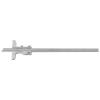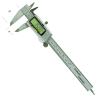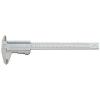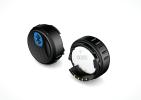What is a calipers?
There are many tools we can use to take measurements, but calipers are the most versatile. What is a caliper? It is a tool suitable for defining the width of an object, the distance between two sides of an object or between two flat surfaces in a concavity, the depth of a hole and more.
The best known traditional instrument is the twentieth caliper, whose vernier has a length of nineteen millimeters with twenty divisions, but there are also different versions, such as the decimal, the fiftieth, the centesimal and even the penta-thousandth.
By using a caliper you can measure, with an accuracy down to 0.01mm, everything that wouldn’t otherwise be easily measurable with any other tools. Even if the manual calipers such as the vernier and dial ones are still very common, nowadays digital calipers have become more popular: this mainly happened because they are both easier to use and far more accurate.
What are the advantages of a caliper?
The advantages of calipers are many, here are some of them below:
- Outstanding accuracy: calipers are developed to provide increased precision, which is particularly important for industries such as engineering, manufacturing, or construction where precision is critical.
- They are easy and intuitive to use, allowing measuring objects in a quick, efficient way, which can save time compared to other measurement methods.
- They offer different measurement modes as well as large measuring ranges. In fact they can be used to make absolute or relative measurements.
- Calipers are in general small and compact, making them easy to carry around and use in various locations.
Many people often ask “Why is a caliper better than a ruler?”. The answer is that, while a standard ruler can measure length to the nearest millimeter, a caliper can determine length to the nearest 0.01 millimeter. So, the caliper is an incredibly fine measuring tool as it can measure extremely small differences in length. Furthermore, calipers can provide quick measurements, particularly if digital. This can save time compared to using a ruler or other measuring tools. Lastly, through the use of these versatile instruments, you can measure cylindrical, spherical, as well as irregularly shaped objects. Rulers, on the other hand, are typically best suited for measuring flat, straight surfaces.
How to choose a caliper?
Whoever needs to take accurate measurements with a caliper asks “How do I choose the right caliper?”. There are a thousand different models of this tool, so it is of fundamental importance to know by what criteria you should buy a caliper.
- First of all, you have to think about the application environment: there are a lot of calipers designed to be used in contact with water and fluids, while others are perfect for dry places.
- Then, you have to keep in mind the accuracy you need: if you are going to make a highly professional and precise job, you need a professional digital model with a resolution between 0.005 mm and 0.001 mm.
- Next, consider the type of measurement that should be carried out. Do you need to measure inside or outside dimensions, depths, or lengths? This will influence the choice of the most appropriate model.
- Take into account the reputation of the brand and the price of the caliper. Even if it is tempting to choose the cheapest option, the investment in a high-quality gauge can pay off in the long run by providing accurate and reliable measurements.
- As calipers are in different sizes and can take a broad spectrum of measurements, choose a caliper that has a range suitable for the objects you need to measure.
- Last but not least, always choose calipers made from high-quality materials, designed to withstand frequent use as well as to last for many years.
Each type of calipers has its merits and faults, so which one to choose it’s up to you. Here’s a brief guide on the most common types of this tool you can find on the market.
Types of caliper
These are similar to a slide rule: they are completely stick shift, so they are perfect for those who don’t get confused easily when it comes to reading numbers and measures. They have no dial nor display, so reading must be calculated directly on the body (by lined increments): due to misinterpretation, they are hard to read. Still, they are sturdy and shock resistant, in addition to being less expensive than dial and digital models.
Here are some examples of vernier calipers:
- The Metrica workshop vernier caliper in hardened stainless steel and matte chrome scale, for measurements from 0-150 mm (code 10075)
- USAG 960 twentieth vernier caliper, for internal and external measurement with beam and vernier of hardened stainless steel with protruding sliding guides (U09600010)
- The Facom universal caliper for internal, external and depth measurements (code 805.1)
- The Metrica precision caliper, made of hardened stainless steel and provided with 4 ways of measurement, for sizes from 0-155 mm, sold in a practical leather case (code 10055)
- Stahlwille vernier caliper 12900N, with vernier readings 1/20 mm and 1/128″, engraved scale, mm and inch subdivision (77371001)
- TESA TECHNOLOGY robust universal vernier caliper, realized in high quality hardened stainless steel (00530110)
Often it is difficult to read the measures, as they are written in small print. For this reason, the use of a magnetic lens for vernier instruments (Tesa Technology 0051610365) is very useful.
These kinds of calipers are relatively easy to use. They have a lined dial that shows the measurement value, which has to be added to the value of the slide in order to obtain the exact and final measurement. Their cost is a little bit higher and they are less shock resistant compared to vernier ones, but they are perfect tools for those who need a professional precision caliper without spending much.
How much can a dial caliper measure? In general, dial calipers have a range of around 6 inches or 150 millimeters. However, there are some models able to measure up to 12 inches or 300 millimeters.
Examples of dial calipers are the following:
- The Metrica dial caliper in hardened stainless steel, with four measuring functions, an hidden rack, a dial that can be reset in any position and screw locking (this tool is available in the 0-150 mm version and in the 0-200 mm version with respective codes 10023 – 10024)
- The dial vernier caliper by Tesa Technology, an easy-to-read instrument thanks to the large, high-contrast dial (00510008)
- The Wiha DIALMAX dial vernier caliper for internal, external and depth measurements (27082)
- The Fervi stainless steel dial caliper, able to guarantee an accuracy of 0,02mm. This model conforms totally to the DIN 862 standard (C006/150).
How does a dial caliper differ from a vernier caliper?
Dial and vernier calipers are widely used in industrial as well as engineering applications. Both models have their own properties and strengths. Here are some key differences between the two:
- The dial caliper has a higher resolution than a vernier one,
- The dial caliper can be read easier than a vernier caliper.
- A vernier caliper is generally less expensive than a dial model.
- Dial calipers are offered in a one-unit system, while vernier calipers can show values in both mm and inch.
- Digital calipers
These are the ultimate tools for those who definitely aren’t math people, but also for taking highly precise measurements. They accurately display up to 0.025mm (0.001”) on a screen and can take absolute and incremental measurements. Considering all this, the answer to the question “Which type of caliper is the easiest to use?”, particularly frequent among customers, is surely the digital ones, as they show the values directly on their screen.
Some examples of digital calipers that you can find on our site are the following:
- Facom digital vernier caliper, with reading ruler with patented inductive measuring system (code 1320)
- Stahlwille 12900 / 1N digital vernier caliper, featuring a large, easy-to-read LCD display (77371002)
- The Metrica digital caliper with giant numbers (11 mm) and four measurement functions (code 10017)
- The universal digital caliper by Tesa Technology, certified IP67, and equipped with a connected Bluetooth transmitter for sending data (code 00530140)
The digitization of measurement tools has made it possible to achieve constant progress and to make work considerably easier. For example, while it once took some familiarity to accurately read the Vernier scale, digital calipers instantly show measurements in units down to 1/100.
What do the numbers mean on a digital caliper?
The numbers on a digital caliper indicate the measurement of the object to be analysed. The digital display generally shows the measurement in the unit of measurement chosen by the user, such as inches or millimeters. The main number shown is the actual measurement itself, which is indicated by a number of digits after the decimal point, depending on the level of accuracy chosen by the user.
What are the disadvantages of digital calipers?
Digital calipers are generally considered to be extremely reliable and quick to use. But like all tools, they have some disadvantages. Digital calipers are more likely to be damaged from a shock, since their electronic components are more delicate than the ones of traditional measuring tools. Moreover, they may lose accuracy if you work under extreme temperatures, as well as in contact with oil or dust. In order to prevent this latter problem, you can buy calipers with IP67 certification, which gives them impermeability to dust and water and, as a consequence, a longer durability. Another important thing to point out is that, when using a digital caliper, batteries are needed to power the electronic display and sensors. Otherwise, the device won’t work. As a consequence, remember to keep spare batteries always with you, so you don’t risk finding yourself with a dead caliper while you work.
However, in digital instruments, the display can often change due to the force adjustment applied when the measured value exceeds the accuracy limit. Especially in the case of models which can measure in units up to 1/1000, depending on the target the measured value may not be fixed, which can lead to confusion as to which value to select.
What to look for when buying digital calipers?
If you want to buy a digital caliper, there are several factors to consider to ensure that you select a high-quality, reliable tool. Here are some key things to take into account when purchasing a digital caliper:
- Accuracy: Look for a tool that offers an accuracy within 0.001 inch or 0.02 millimeters. Check user reviews or technical specifications to define the level of accuracy offered by the caliper.
- Measurement range: Always be sure that the range is suitable for the objects you need to measure.
- Material and durability: Choose a model made from high-quality, long-lasting materials such as stainless steel. It is commonly used for realizing digital calipers as it offers strength, as well as corrosion resistance.
- Display: Look for a model with a display offering a large, easy-to-read readout, with clear markings for each digit.
- Battery life: Buy a caliper with a long-lasting battery life or that functions with a common battery type, easy to replace.
- Brand reputation: Look for a reputable brand of digital caliper, with a proven track record of producing high-quality measuring instruments. Producers like Metrica, Tesa Technology or Fervi are renowned for the quality, the accuracy as well as the performances of their digital calipers. On Mister Worker™, you can purchase the top-of-the-range models of these famous brands, in just a few clicks.
- Depth calipers
Another example of widely used caliper is the depth gauge, used to measure the depths of grooves, cavities, blind holes, steps, and much more. This type of professional caliper is composed of a millimeter rod, which goes to the bottom of a cavity, and a ground base to rest on the top of the hole. Generally the support base is solid and wide, in order to almost completely prevent the inclination of the gauge and, consequently, reduce the chances of obtaining measurement errors.
On our store you can find several examples of depth gauges and related accessories, let’s see some of them:
- The Tesa Technology depth caliper with pointed internal jaws, whose high contrast and large display ensures easy reading of the values (code 00530441)
- Facom digital display depth gauge, equipped with a reading ruler having in turn a patented inductive measuring system (code 1350)
- Metrica depth vernier caliper, made of hardened stainless steel and equipped with a matte chrome scale and a practical screw locking system (10151)
- Usag fiftieth sliding depth gauge, provided with a hardened stainless steel body and protruding sliding guides (U09630001)
- The basis for depth measurements for universal calipers (00560055)
What type of caliper is most accurate?
In general, digital calipers are considered the most accurate ones. This is because they provide highly precise measurements, often to within thousandths of an inch or hundredths of a millimeter, through the use of electronic sensors. Then, the digital display on these calipers also allows users to read the measurement clearly. So, the answer to the frequently asked question “Are digital calipers the most accurate?” is definitely yes.
Dial calipers are also considered remarkably accurate, as they provide precise measurements to 3 decimal places, or 1/1000th of an inch. Regarding this model, the measuring procedure is divided into two parts, as it uses both a main scale and a dial gauge.
It’s important to note that accuracy can vary depending on the quality of the caliper as well as the conditions under which the measurements are taken. Ultimately, the most accurate type of caliper for a particular application will depend on the specific requirements of the task at hand.
Are digital or dial calipers better?
Both types have their advantages and disadvantages, and the choice between the two largely depends on the specific needs of the user. Here are some factors to consider when choosing between digital and dial calipers:
Digital Calipers:
- Highly accurate and precise measurements,
- Easy to read digital displays
- Ability to perform quick and easy conversions between metric and imperial units.
- Typically require batteries and may be more expensive than dial calipers.
Dial Calipers:
- Provide accurate measurements, often to within thousandths of an inch or hundredths of a millimeter.
- Do not require batteries and are generally more durable than digital calipers.
- May be easier to use for some users, particularly those who are more accustomed to analog instruments.
- It can be more difficult to read for users who are not used to interpreting dial readouts.
Overall, the choice between the two largely depends on personal preference as well as the specific needs of the user. If high precision and ease of reading are a priority, digital calipers may be the better choice. If durability and ease of use are more important, dial models can represent the most appropriate option.
Where to buy calipers
Vernier, dial or digital calipers are available both in physical and online stores. If you prefer to purchase them on the net, you should definitely choose Mister Worker™, the online shop for MRO-tools and equipment. Thanks to our shop, you have the opportunity to order the most famous models of worldwide renowned brands like Metrica, Tesa Technology, Fervi or Stahlwille, with the advantages of outlet prices and immediate delivery.
Related products
Sliding depth gauges to…

DIGITAL CALIPER BIG DIGITS…

Analogue callipers dialMax…

12900N Vernier calliper

Vernier caliper to 1/20 mm

TLC-BLE transmitter
